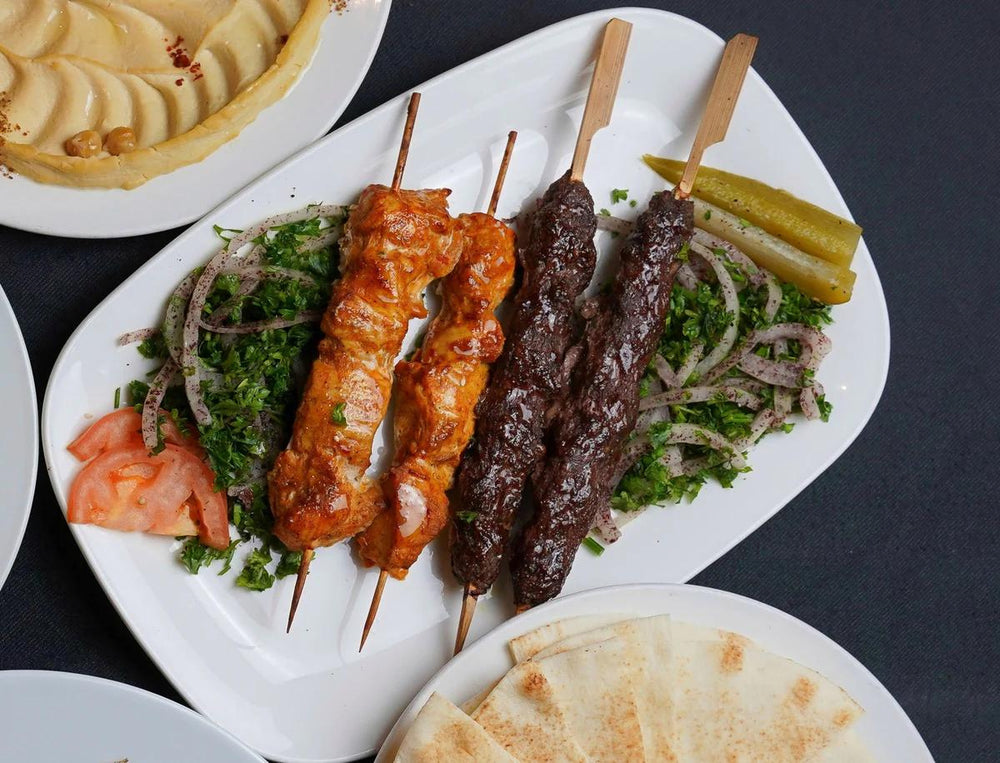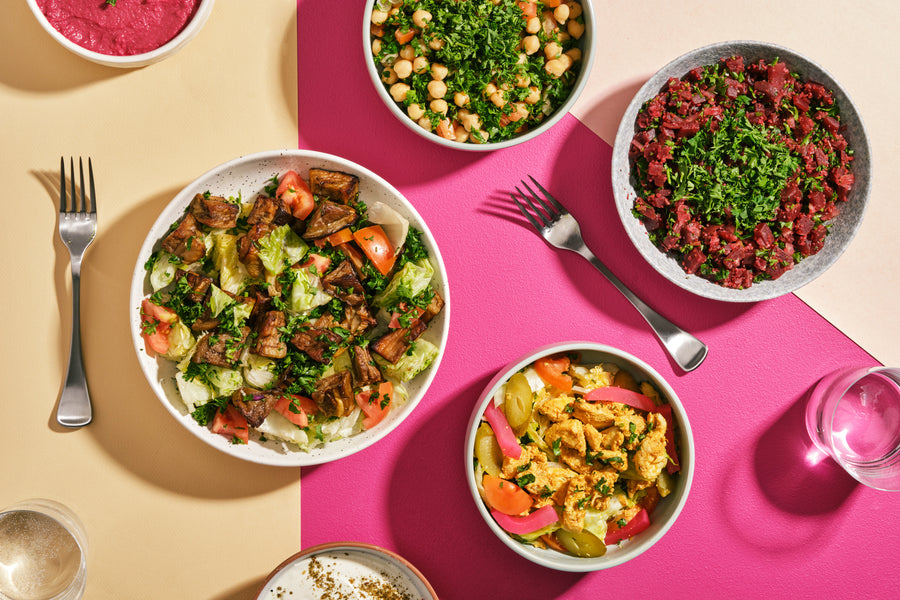All Regarding the Rich Flavors and Traditions of Syrian Food: A Culinary Trip
Syrian food supplies an one-of-a-kind mix of tastes and customs that mirror its abundant social background. With staple components like olive oil and garlic, along with a variety of seasonings, the recipes are both diverse and inviting. From the intricate preparation of kibbeh to the sweet allure of baklava, each facet of this culinary landscape reveals much deeper stories. As one explores the essence of these tastes, a higher understanding of communal dining and party emerges.
The Essence of Syrian Ingredients
The significance of Syrian components depends on their rich diversity and ingrained cultural importance. Influenced by the nation's varied location and history, Syrian cuisine includes a vast array of seasonings, herbs, and fresh fruit and vegetables. Staples such as olive oil, garlic, and lemon give a structure, while spices like sumac, coriander, and cumin add depth and intricacy to dishes.The use fresh herbs, including parsley and mint, highlights the importance of seasonal active ingredients. Furthermore, the region's productive soil yields a wealth of vegetables and fruits, such as tomatoes, pomegranates, and eggplants, which are important to many dishes. Grains like bulgur and rice form the base of several meals, emphasizing the significance of these ingredients in Syrian culture. This mix of flavors shows not just a culinary custom yet also a tapestry of historical influences, making Syrian components necessary to recognizing its food's vibrant personality.

Iconic Cuisines of Syrian Cuisine
Syrian food is renowned for its famous dishes that display a rich tapestry of structures and tastes. Traditional meze plates supply a variety of tiny meals that entice the taste buds, while hearty main dishes offer satisfying centerpieces for dishes (Afternoon Tea Vancouver). To finish the experience, an option of delicious treats adds a wonderful note to the culinary trip
Traditional Meze Plates

Hearty Key Courses
Hearty main training courses act as the focal point of Syrian dining, showcasing a blend of flavors that mirror the country's rich cooking traditions. Meals such as kebab hindi, featuring marinaded lamb skewers, and the well known mujaddara, a calming mix of lentils and rice, highlight the use of aromatic spices and fresh active ingredients. An additional staple is the renowned kibbeh, made from bulgur wheat and minced meat, typically offered in different types, including baked, fried, or raw. Furthermore, the flavors of the land come alive in meals like packed vegetables, referred to as mahshi, which are filled with rice, meat, and herbs. These main dishes not only please appetite however additionally inform stories of family celebrations and social heritage.
Scrumptious Treats Option
A delightful variety of desserts defines the sweet side of Syrian cuisine, offering an alluring end to any type of meal. Among the most renowned confections are baklava, delicate layers of phyllo bread filled with nuts and drenched in syrup, and maamoul, shortbread-like cookies usually packed with dates or nuts. Knafeh, a rich dessert made from slim noodle-like pastry soaked in syrup and layered with cheese, is a preferred option, especially during cheery events. Additionally, the fragrant and sweet rice dessert, referred to as roz bil laban, gives a comforting coating. These delectable treats not just display the region's cooking expertise but also mirror the social heritage of Syria, making them treasured treats in both homes and restaurants alike.
Standard Food Preparation Techniques
Contemporary benefits have influenced lots of culinary practices, traditional cooking methods continue to be necessary to Syrian cuisine. These techniques usually highlight the use of fresh, seasonal ingredients and concentrate on slow-moving food preparation to establish abundant tastes. Methods such as barbecuing, braising, and stewing prevail, permitting the all-natural tastes of the active ingredients to radiate through.One remarkable technique is the prep work of kibbeh, a meal made from carefully ground meat and bulgur. It needs proficient hand-rolling right into various forms and can be baked, fried, or offered raw. Additionally, the art of making bread, particularly pita, is main to many dishes, commonly cooked in a typical stone oven.Preservation techniques like pickling and fermenting also play a crucial duty, enhancing the diversity of flavors located in Syrian recipes. These techniques not only show the area's farming heritage however additionally foster a solid sense of area through shared cooking practices.

The Function of Spices in Flavor
Spices serve as the heartbeat of Syrian cuisine, infusing dishes with intricate tastes and aromatic deepness. Each flavor plays an essential role, adding not just to preference however also to the social heritage of the area. Frequently used flavors include coriander, sumac, and cumin, each using a distinct account that raises standard recipes. For example, cumin gives warmth and earthiness, while sumac adds an appetizing illumination, enhancing the general dish.Syrian cooks commonly blend flavors to produce harmonious accounts, reflecting the intricate equilibrium of tastes that specify the food. The usage of spices is not simply for spices; it additionally offers to preserve food and improve its nutritional worth. This thoughtful consolidation highlights a deep understanding of the cookeries, where flavors come to be important authors, sharing the abundant history and diverse impacts that identify Syrian gastronomy. Inevitably, flavors are vital in crafting memorable and genuine Syrian recipes.
Festive custom-mades and congratulatory dishes
Celebratory dishes in Syrian food are marked by traditional feast recipes that mirror the country's abundant culinary heritage. Special celebrations typically involve special routines that improve the common experience of dining. These customizeds not just honor the importance of the occasions yet likewise enhance domestic and cultural bonds.
Traditional Banquet Cuisines
When households collect to commemorate substantial events in Syria, traditional banquet recipes take spotlight, showcasing the rich culinary heritage of the region. These celebrations often include vivid platters of mezze, consisting of hummus, baba ghanoush, and tabbouleh, which act as delightful starters. The main dish commonly highlights lamb or hen, marinaded and prepared to perfection, often gone along with by aromatic rice pilaf or bulgur. One of one of the most precious meals is maqlooba, a layered rice meal with vegetables and meat, flipped upside down prior to serving. Sugary foods additionally play a vital role, with baklava and knafeh offering a sweet coating to the dish. Each recipe not only delights the taste yet additionally shows the ingrained practices and common spirit of Syrian society.
Unique Celebration Routines
Special celebrations in Syria are noted by abundant rituals that link food and celebration, reflecting the cultural value of common gatherings. Commemorative dishes commonly consist of standard dishes such as kibbeh, tabbouleh, and different smoked meats, prepared with treatment and shared among family and buddies. Throughout religious holidays like Eid al-Fitr and Eid al-Adha, households collaborated to prepare special sweets like maamoul, signifying unity and joy. Wedding celebrations are particularly fancy, including numerous training courses and lively screens of hospitality. These occasions are not merely regarding food; they include narration, songs, and dance, enhancing social bonds and social heritage. With these routines, Syrians commemorate life's turning points, making certain practices are passed down with generations, enhancing their culinary landscape.
The Significance of Sharing and Community
Sharing meals is an essential element of Syrian society, showing the ingrained worths of neighborhood and connection. In Syria, food is not just sustenance yet a method of bringing individuals with each my link other. Pals and families collect around the table to appreciate traditional meals, promoting bonds and developing long-term memories. This public dining experience emphasizes hospitality, where hosts go to fantastic lengths to guarantee every guest really feels invited and nourished.The act of sharing food likewise represents generosity and solidarity, enhancing social connections within communities and larger communities. During gatherings, Full Article it prevails for people to serve each various other, showcasing a spirit of togetherness that transcends individualism. Celebrations, whether tiny or huge, are commonly noted by the sharing of dishes, where diverse flavors and recipes collaborated, mirroring the abundant tapestry of Syrian culture. Appropriately, the significance of sharing and community in Syrian food is not only a cooking practice however a critical social method.
A Culinary Expedition of Syrian Sweets
Typically overshadowed by mouthwatering meals, Syrian sweets hold a valued area in the nation's cooking heritage (Afternoon Tea Vancouver). These confections reflect the area's abundant background, blending flavors and methods from various cultures. Conventional desserts like baklava, with its layers of phyllo pastry, nuts, and honey syrup, showcase the virtuosity associated with Syrian cooking. Ma'amoul, a shortbread-like cookie filled with dates or nuts, is frequently gotten ready for cheery occasions, representing hospitality and celebration.Another beloved sweet is Knafeh, a bread taken in syrup and layered with cheese or cream, providing a delightful comparison of appearances. Syrians additionally take pleasure in a range of fruit protects and syrups, typically served with tea or as part of a larger spread during gatherings. These desserts not just please the palate but additionally function as a bridge in between generations, protecting the customs and stories of Syrian society with each savory bite
Regularly Asked Concerns
What Are the Health Perks of Typical Syrian Foods?
The wellness benefits of standard Syrian foods consist of rich nutrients from fresh veggies, legumes, and whole grains. These ingredients advertise heart health and wellness, boost digestion, and provide vital vitamins, contributing to overall health and a balanced diet.
Just How Has Syrian Food Developed Over the Years?
Syrian cuisine has actually developed considerably, influenced by historic profession paths, cultural exchanges, and regional schedule of components. Conventional meals have actually integrated modern tastes and methods while maintaining their abundant heritage, showing a varied culinary landscape.
Are There Vegetarian or Vegan Options in Syrian Cuisine?
Syrian food provides many vegan and vegan choices, featuring meals like falafel, tabbouleh, and stuffed grape fallen leaves. These dishes highlight the area's rich agricultural his comment is here heritage, showcasing fresh veggies, grains, and aromatic seasonings in dynamic combinations.
What Beverages Set Well With Syrian Dishes?
When thinking about drinks that complement Syrian meals, one may discover that mint tea, pomegranate, and ayran juice enhance the meal's tastes. Furthermore, merlot commonly sets well with the flavors generally found in these foods.
How Can I Recreate Syrian Dishes in your home?
To recreate Syrian meals in your home, one need to explore authentic dishes, gather conventional components, and use cooking methods special to the food. Trying out seasonings and discussion likewise improves the total eating experience. Syrian cuisine is renowned for its renowned dishes that display an abundant tapestry of appearances and tastes. Seasonings offer as the heartbeat of Syrian cuisine, infusing recipes with intricate flavors and aromatic depth. Congratulatory meals in Syrian cuisine are marked by typical feast meals that mirror the country's rich culinary heritage. Events, whether small or huge, are frequently marked by the sharing of meals, where varied tastes and dishes come with each other, mirroring the abundant tapestry of Syrian society. Syrian cuisine offers countless vegetarian and vegan alternatives, including recipes like falafel, tabbouleh, and stuffed grape leaves.